Towards Gender Equality Newsletter Issue #5: Gender and Entrepreneurship

A little over a decade ago, the prevailing wisdom in development economics was that women-owned microenterprises generated no returns to additional capital, while men-owned microenterprises generated very high returns. We accepted this stylized fact without deeper interrogation until Bernhardt et al (2019) revisited the data from the original capital shock experiments to examine until-then hidden intra-household dynamics. They conclude that “the absence of a profit response among female-run enterprises reflects the fact that women's capital is typically invested into their husband's enterprise. We cannot reject equivalence of household-level income gains for male and female capital shock recipients.”
There are a host of research projects currently examining the black box of enterprise dynamics and growth from a gender lens. We highlight a forthcoming paper that illuminates how women-led enterprise activity relates to women’s employment prospects and wage levels, and recent work that digs into the drivers of gender profit gaps, including on the demand side. We hope you will find these insights as compelling as we have.

Aishwarya Lakshmi Ratan
EGC Deputy Director
Research Highlight
Aggregate Implications Of Barriers To Female Entrepreneurship
Chiplunkar & Goldberg [Working Paper, forthcoming, Econometrica]
The lack of business ownership by women across the world is striking, particularly in South Asia (Figure 1). Chiplunkar and Goldberg (2024) develop a unified framework for quantifying barriers to labor force participation (LFP) and entrepreneurship faced by women in India. They run counterfactual simulations – “what-if” scenarios – to then evaluate how various policy interventions would impact women’s welfare as well as aggregate productivity and real income, after taking into account changes in occupational choices, prices, wages, etc. for both men and women in equilibrium. Their approach helps in understanding why relaxing one constraint at a time may not be particularly effective when other constraints are binding.
Figure 1. Percentage of Female-Owned Firms Across Regions

Notes: LAC = Latin America and Caribbean; EAP = East Asia and Pacific; EU = European Union; ECA = Europe and Central Asia; SSA = Sub-Saharan Africa; MENA = Middle-East and Northern Africa; SAR = South Asia Region. Data Source: World Bank Gender Data Portal, 2023.
Chiplunkar & Goldberg generate the well-known finding that women in India face substantial barriers to entering the workforce. However, they find that conditional on working, women do not face significant additional costs (relative to men) in starting businesses. Rather, they are constrained in expanding and formalizing their businesses. Second, women entrepreneurs hire more women. This relationship is robust to accounting for gender differences in the industries, sectors, regions, and family-owned businesses. It therefore creates a powerful link between promoting female entrepreneurship and increasing female LFP —policies that boost one could significantly increase the other.
Although their framework (by design) is not geared towards evaluating or recommending specific policies, their analysis has significant implications for policy design.
Insight 1: Policy should focus on the expansion, rather than just entry, of women-owned businesses
At present, most policies aimed at supporting female entrepreneurship, both in India and globally, focus on enabling women to start new firms and/or encouraging them to formalize their businesses. However, Chiplunkar & Goldberg find that policies that support the growth of existing women-owned businesses have a far greater impact than those simply seeking to increase the number of women-owned businesses instead.
Insight 2: Policy that supports women entrepreneurs also benefits female labor force participation
Policies that encourage female entrepreneurship have a multiplier effect because they can also lead to a significant increase in female labor force participation. When more women become entrepreneurs, more women are also willing to enter the labor force and become wage-earners, since female entrepreneurs hire more female workers.
Insight 3: Policy should address both demand-side and supply-side constraints
Chiplunkar & Goldberg show that removing barriers to female LFP alone, without addressing the demand for female workers, could lower real wages for women. But when demand-side barriers that constrain female entrepreneurship are addressed alongside supply-side LFP barriers, the overall effect is positive: more women in the labor force (both as entrepreneurs and wage-workers), higher wages, and greater productivity.
Featured Researcher: Morgan Hardy
Morgan Hardy is an Associate Professor of Economics in the Social Science Division of New York University Abu Dhabi and a JPAL and BREAD affiliate. Her research has a topical focus on firms and labor markets often involving field experiments and/or original data collection in Africa, and she has a cross-cutting interest in gender inequality and data gaps.

Morgan Hardy.
In a recent working paper, Hardy and co-authors ask why commonly available enterprise data sources in sub-Saharan Africa show lower rates of women-owned enterprise representation compared to household surveys (see abstract below). Other recent work studies the allocation of labor across small firms and improving apprenticeship training. Previously, with co-author Gisella Kagy, Hardy has investigated how demand constraints affect the gender profit gap, and examined reasons for the gender profit gap among garment making firms in a midsize district capital in Ghana, finding that the gap is driven by factors other than individual firm characteristics or firm-owner characteristics.
See Hardy’s website for more information.
“Gender inequality is one of humanity’s oldest and most pervasive issues. In a world that is increasingly data-driven, where quantitative empirical methodologies drive leadership decisions and shape our experienced reality, existing inequalities can become automated and amplified. It is essential for an inclusive society to identify the gaps in existing data infrastructures and the resulting blind spots in rigorous quantitative empirical approaches.”
- Morgan Hardy
New Research
Historical Differences in Female-Owned Manufacturing Establishments: The United States, 1850-1880
Gozen, Hornbeck, Humlum, Rotemberg [Working Paper]
The authors characterize female-owned manufacturing establishments using newly digitized manuscripts from the US Census of Manufactures (1850, 1860, 1870, 1880). Female-owned establishments were smaller than male-owned establishments and had lower capital-to-output ratios, which could reflect more-constrained financial access and other distortions. Female-owned establishments employed more women and paid women higher wages, creating a potential cycle between increased female business ownership and increased female labor market participation. Female-owned establishments concentrated in sub-industries like women's clothing and millinery, which is associated with some but not all of these differences. The authors also show how female owners differed from other women in the Population Census.
Cultural Norms and the Gendered Impact of Entrepreneurship Policy in Mexico
Raines, Polhill, Hiatt, Coles [Working Paper]
This article explores how policies that reduce barriers to entrepreneurship impact underrepresented groups differently depending on local norms and cultural beliefs. While prior studies suggest that underrepresented groups should benefit more than other groups do from policies lowering entry barriers, the empirical evidence is mixed. The authors argue that the absence of normative and cognitive support can undermine the effectiveness of these policies for underrepresented groups. To explore this, the paper leveraged the staggered rollout of a policy that reduced entry barriers to entrepreneurship in Mexico. The results show that while the policy increased the number of businesses founded by men, it had a small and statistically insignificant impact for women, thus exacerbating the gender gap in entrepreneurship. Further analyses suggest that while women were not more likely to become involved in entrepreneurship as founders, they did become engaged in alternative roles within new ventures, often leaving other forms of employment to enter unpaid work in businesses founded by men in their household. The effects of the policy on the gender gap in entrepreneurship and unpaid work were more pronounced in areas with a strong patriarchy logic and among married individuals. This research highlights the need to consider context in the design of policies intended to encourage entrepreneurship.
Beyond Borders: Do Gender Norms and Institutions Affect Female Businesses?
Gorg and Jäkel [Working Paper]
This paper investigates whether gender norms and institutions act as a constraint to the performance of female businesses. The authors exploit novel and unique micro data on start-ups in Denmark, which they combine with information on individual-level characteristics of the entrepreneur as main decision maker of the firm. The paper overcomes the challenge of disentangling norms and institutional biases against women from other constraints and hurdles that female businesses might face by exploiting detailed trade data. In this trade context, the authors study the relative performance of firms across markets with varying institutions, while controlling for other factors that affect female businesses uniformly across all markets. The paper provides evidence that gender inequality and institutional biases against women in trade partner countries play an important role in explaining gender differences in export and import behaviour. The authors also perform an event study of a concrete policy change in a destination market - the introduction of quotas for the share of females on the boards of directors in Norway - and how it has affected the gender gap in trade participation.
Rural Roads, Small Business Creation, and the Gender Gap in Entrepreneurship
Agarwal, Ghosh, Mukherjee, Naaraayanan [Working Paper]
The authors study the causal effect of new roads on small business creation, using a population threshold-based road-building program in rural India. Findings reveal a doubling of new microenterprises in these villages after the program, compared to a 7.5% increase in their belowthreshold counterparts. Three channels contribute to this growth: First, paved roads expand access to nearby town markets. Second, all-weather paved roads free villages from disruptions in accessing external input/output markets during the monsoon season, which especially matters for new business creation in flood-prone areas. Third, the increase in new businesses is largely driven by ten times as many new businesses started by women in villages with new roads as before, leading to a substantial reduction in the pre-existing gender gap. Two mechanisms, in turn, contribute to this reduction: an erosion of patriarchal social norms resulting from men migrating to towns for work; and a reduction in the time women have to spend on childcare, due to connectivity-induced improvements in local schools. Finally, such women-led businesses tend to hire other women in conservative rural India, leading to a sizeable increase in job opportunities for them.
Mind the Data Gaps: An Examination of Women-Owned Enterprise Representation
Hardy, Kagy, Jimi [Working Paper]
This paper documents large variations in women-owned enterprise representation and estimates of gender gaps in enterprise performance across commonly available data sources in Sub-Saharan Africa. The authors provide empirical evidence that these differences are driven by differences in gender-blind sampling protocols. Women-owned enterprises are less likely to meet the sampling criteria for most widely available enterprise data. Those that do meet the criteria are more positively selected on performance, relative to male-owned enterprises. The authors also document differences in implied policy and research priorities across these data sources, driven both by target sample characteristics and survey structure. Their findings caution the secondary use of commonly available enterprise data for gender equity and inclusion research and highlight a potential representation issue in insights drawn from such data.
Policy Engagement, Events & Media Coverage
EGC’s Director Rohini Pande participates in World Bank High Level Advisory Council on Jobs
[World Bank Press Release, August 12, 2024]
On October 23 on the side of the 2024 Annual Meetings of the International Monetary Fund (IMF) and the World Bank Group (WBG), EGC’s Director, Professor Rohini Pande participated in the World Bank Group High Level Advisory Council on Jobs. The Council focused on driving future prosperity especially for youth and women, and was co-chaired by Tharman Shanmugaratnam, President of the Republic of Singapore, and Michelle Bachelet, the former President of the Republic of Chile, alongside Ajay Banga the President of the World Bank.
Why female entrepreneurs are key to getting more women to work
[BBC article, October 28, 2024]
The BBC’s Soutik Biswas features findings from Chiplunkar and Goldberg’s paper "Aggregate Implications of Barriers to Female Entrepreneurship,” which is featured as the Research Highlight of this newsletter.
Broadening the horizon: Female representation on editorial boards and gender-related publications
[VoxDev Article, November 1, 2024]
EGC Postdoctoral Scholar Patrick Agte, Postgraduate Associate Carmen Abaizar, and Director Rohini Pande wrote a VoxDev blog post that asks how having more women on the editorial boards of top economics journals influence what gets published. They reveal that as female representation on editorial boards rises, more gender-related research is being published, diversifying the topics explored within economics and benefitting female researchers.